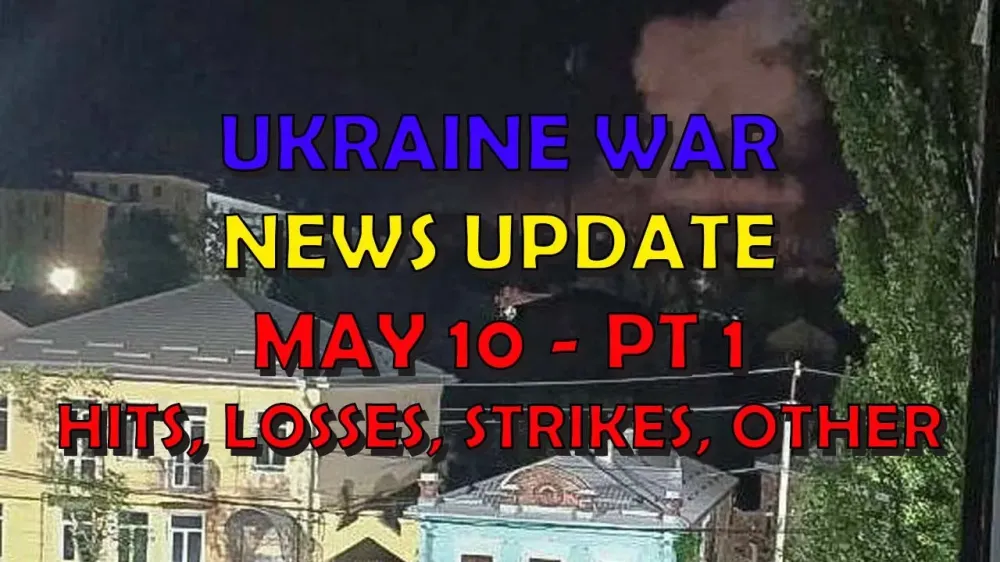Ukraine War Update NEWS: Pt 1 - Overnight & Other News
Table of Contents 📖
“It's Yorkshire tea all the way, made in the same way I make it all the time.”
Hello Team
🎦 00:00-01:04⏩
Jonathan welcomes viewers to another Ukraine War News Update, apologising for the slight delay caused by home repairs and a chat about “cabbages and kings” over tea. He fondly recalls the previous night’s engaging live stream with Greg Terry, humorously remarking on some viewers' "Russian-backed disinformation" regarding his tea preferences (it's Yorkshire Tea, always!).
Return to top⤴️
🪦 DISCLAIMER FOR GENERAL STAFF LOSSES DATA
- These are real people with real lives and real families who love them. Don’t let the numbers sap your humanity.
- These numbers probably aren’t accurate but they’re the best we have and we don’t need them to be accurate to be indicative of patterns of activity.
- All losses are estimates. Losses cannot be counted with accuracy because of the conditions on the ground.
- Both sides would see it to be of their advantage to minimize their own losses maximize the other side’s losses.
- Neither side releases their losses but we have enough transparency from the Ukrainian side to have confidence in they are indicative.
- Personnel losses are hard to count. If a soldier gets injured, heals up, and returns to the front line only to get injured again, is that one loss or two? Also, how to deal with losses from PMC’s or soldiers fighting with RF from occupied territories?
- Equipment losses are hard to count. If an AA complex involves several parts and one part gets disabled, is that a loss, or a fraction of a loss? If a tank gets disabled, repaired, back into the fight, then disabled again, is that one lost tank or two?
- All recorded losses are vulnerable to multiple reporting. We have already seen numerous cases of multiple drones in the air reporting the same loss from different angles as multiple engagements.
- Losses are not always reported on the same day they occurred. It is frequent that drone losses are reported at least 24 hours after other terrestrial equipment losses. Certain losses may not be reported for days or weeks for military intelligence reasons.
Ukrainian General Staff Daily Losses - Russia
🎦 01:04-03:18⏩
Jonathan delves into the Ukrainian General Staff's reported Russian losses, emphasizing the significance of trends over precise figures. He highlights the high number of Russian personnel lost (980, nearing 1,000, which he considers a benchmark for a high-casualty day) and speculates on potential contributing factors, such as increased attacks or troop accumulations being targeted. Jonathan also notes the substantial losses in Russian equipment, including 5 tanks, 32 armoured personnel vehicles, and 47 artillery systems (a "really bad day" for Russian artillery), indicating the effectiveness of Ukrainian countermeasures. He maintains that even with potential discrepancies, the consistent trends revealed by these figures offer valuable insight into the war's progression.
Return to top⤴️
Andrew Perpetua’s Visually Confirmed Losses
🎦 03:18-09:04⏩
Jonathan discusses Andrew Perpetua's visually confirmed loss statistics, noting the deletion of the previous day's data and expressing curiosity about its content. The current data indicates a favourable loss ratio for Ukraine, nearing 3:1, signifying improvement from recent days of parity. Ukrainian losses include a recovery vehicle, artillery pieces, tanks (including a Leopard 2A4 damaged by a potentially misfired FPV drone), abandoned APCs, and pickup trucks. Conversely, Russian losses are significant, with a high proportion of equipment listed as destroyed or abandoned rather than damaged, suggesting limited recoverability. He lists destroyed Russian equipment, including:
- Surveillance and communication equipment
- A boat
- Three T-90s
- Numerous T-80s
- A T-55 (unusual due to their limited frontline deployment)
- A multitude of BMP-1s, BMP-2s, and BMP-3s (supporting the high number of IFV losses reported by the Ukrainian General Staff).
Jonathan observes a trend of smaller Russian attack columns, often consisting of 3-5 vehicles, and highlights the increased use of vulnerable quads and motorbikes, speculating that this shift stems from dwindling equipment supplies rather than tactical adaptation.
Return to top⤴️
The Effectiveness of FPV Drones
🎦 09:04-13:26⏩
Jonathan shifts focus to the rising impact of FPV drones, referencing three videos (linked in the description) showcasing their devastating effectiveness against a wide array of targets, from personnel and dugouts to various military vehicles. He commends the 58th Mechanized Brigade for releasing a compilation of successful FPV drone strikes, demonstrating the widespread deployment and devastating impact of these weapons. The abundance of such videos, he argues, underscores the rapidly evolving role of drones in warfare, becoming an increasing threat to both sides. He cites a Ukrainian medevac report attributing 90% of their recent casualties to drone attacks. He provides a detailed account of a specific video, highlighting the systematic dismantling of a multi-storey building housing Russian drone operators. Jonathan expresses astonishment at the precision and power of modern drones, capable of targeting load-bearing walls and effectively "deconstructing" entire structures with repeated strikes. This, he believes, showcases the remarkable evolution of drones from their initial role as anti-tank weapons to their current capacity for targeted demolition and significant destruction.
Return to top⤴️
Ukrainian Magura V5 Naval Drones
🎦 13:26-14:56⏩
Jonathan discusses the Ukrainian-made Magura V5 naval drones (also known as "Sea Baby" USVs), which have inflicted an estimated $500 million in damages to the Russian Black Sea Fleet. These unmanned surface vehicles have successfully targeted and neutralized various Russian vessels, including:
- Two landing ships
- The missile corvette Ivanovets
- The larger landing ship Caesar Kunikov
- The patrol ship Serge Kotov
Jonathan highlights the consistent threat these drones pose to Russian naval capabilities in the Black Sea, noting their evolving capabilities, such as the integration of surface-to-air missiles, potentially for engaging helicopters, demonstrating their adaptable and potent threat in modern naval warfare.
Return to top⤴️
Distance Strikes
🎦 14:56-23:03⏩
Jonathan discusses overnight distance strikes, describing a successful evening for Ukraine in targeting Russian oil refineries, while Russia struggled, with all 10 drones sent into Ukraine (primarily Odessa, Mykolaiv, and Kherson regions) being intercepted.
- Kharkiv: Jonathan notes a potential shift in focus towards Kharkiv, with the city experiencing heavy shelling and missile strikes over the past 24 hours, raising concerns of a possible Russian offensive. He references discussions on the previous night’s livestream with Greg Terry, where they debated the likelihood of such an attack. While some speculate that Russia might target Kharkiv to secure a significant victory and pressure Ukraine into negotiations, Jonathan deems a full-scale assault on Ukraine's second-largest city "suicidal", citing the extensive minefields, fortifications, and insufficient Russian troop and equipment numbers. He questions whether the increased activity signals a genuine offensive or a diversionary tactic. He reports on the injuries sustained by an 11-year old child and a 72-year old woman following Russia's missile attacks on residential infrastructure.
- Sumy: Explosions are reported in Sumy, a city west of Kharkiv.
- Odesa: Jonathan reports a missile strike on Odesa, believed to be from Iskander-M ballistic missiles, highlighting Russia's ongoing attempts to cripple Ukraine's economy and disrupt its grain export operations via the Black Sea and Danube River routes. He emphasizes the strategic importance of Odesa, which has been subjected to increased Russian attacks in recent weeks.
- Kaluga Oil Refinery: Jonathan reports a significant Ukrainian strike on the Kaluga Oil Refinery, the largest in the Kaluga region of Russia. This facility, previously targeted in March, is crucial for processing commercial oil and gas condensate, with a refining capacity of 1.2 million tons annually. The attack ignited three tanks containing diesel fuel and one with fuel oil, although no casualties were reported. Jonathan acknowledges the uncertainty surrounding the refinery’s operational status but acknowledges the severity of the strike and its potential impact on Russian fuel supplies.
- Mariupol: An explosion is reported in central Mariupol, with smoke billowing from the blast site near a former candy factory repurposed by Russian forces. While Russia claims the damage resulted from debris of a downed missile, Ukrainian sources maintain the factory was deliberately targeted, potentially housing a Russian base or troop concentration.
- Belgorod: Russia claims to have shot down five drones overnight, followed by two more over the Belgorod region, although no mention was made of the Kaluga Oil Refinery attack.
- Drone Capabilities: Jonathan analyses the effectiveness of Ukrainian drones, specifically the ultralight, slow-flying plane-drone used to target the Bashkortostan oil refinery two nights prior. This drone, travelling an estimated 1,300-1,500 kilometres, successfully evaded Russian air defences, prompting questions about Russia’s aerial defence capabilities. He postulates that the drone’s unassuming appearance and slow speed may have contributed to its success, as it wouldn't necessarily be perceived as an immediate threat. This successful long-range strike, he argues, exposes a vulnerability in Russia’s air defence system. Jonathan also credits the SBU (Security Service of Ukraine) with orchestrating the attack. He expresses surprise at Ukraine's restraint in targeting Moscow during the recent Victory Day parade, which would have presented a prime opportunity given the redeployment of air defences to protect dignitaries, highlighting the symbolic value of such a strike.
Jonathan emphasizes that despite consistent Ukrainian efforts to degrade Russian oil refinery capacity, he'd anticipated even greater Ukrainian drone activity within Russia, acknowledging that some strikes might remain unreported due to successful interceptions.
Return to top⤴️
Other News
🎦 23:03-29:26⏩
Jonathan concludes the first part of his update by covering additional news:
- Russian Economy and Taxes: The Russian parliament is considering tax increases to offset rising wages caused by labour shortages. While presented as a measure that won't negatively impact businesses or citizens, Jonathan suggests it could spark discontent among the Russian workforce.
- Zelensky’s Security & Personnel Changes: Jonathan discusses the recent assassination attempt on Zelensky, commending his security team's success in thwarting the plot, which involved two infiltrated colonels within Zelensky’s security detail, potential missile strikes on his workplace and drone strikes. Jonathan expresses amazement at Zelensky’s survival given the constant threat against him. He draws a comparison to Putin's limited exposure to danger, seldom visiting the front lines or putting himself at risk. He views the attempted assassination as unsurprising given the historical ties and ongoing conflict between Ukraine and Russia, emphasizing the prevalence of sabotage and covert operations by both sides. In light of this, Zelensky has dismissed the head of state security and implemented personnel changes within his administration, including the replacement of the agriculture minister. Jonathan cautions against interpreting these reshuffles as signs of instability, arguing that such changes are common in governments, particularly during wartime, where high stress levels and evolving challenges necessitate fresh perspectives and new approaches.
- Ukrainian Energy Restrictions: Jonathan highlights the Kyiv Independent's report on Ukraine's increasing energy restrictions for businesses and industries due to a power shortage caused by Russia’s successful attacks on critical infrastructure. He acknowledges the challenges posed by these restrictions on Ukraine's defence efforts and overall economic stability.
- Andrew Perpetua’s Losses Data: Jonathan provides an update on the missing Andrew Perpetua's loss data, explaining that it was removed due to errors and has yet to be reposted due to time constraints. He apologises for the inconvenience.
Wrap Up
🎦 29:26-29:39⏩
Jonathan thanks his viewers for their continued support, expressing gratitude for their engagement during the previous night's live stream. He ends the video, reminding viewers to like, subscribe, and share.
Return to top⤴️




